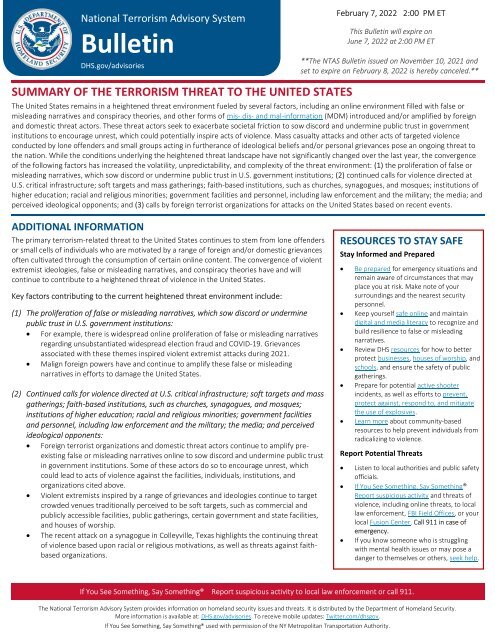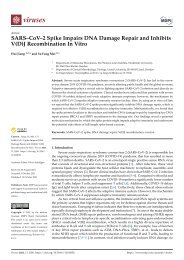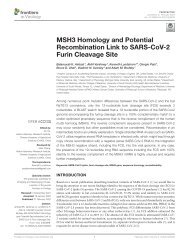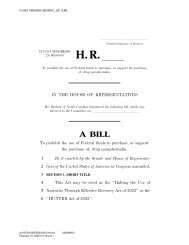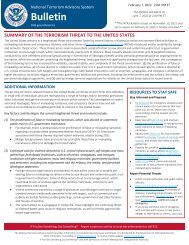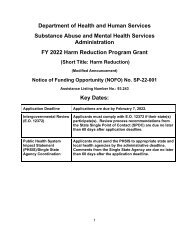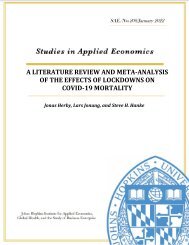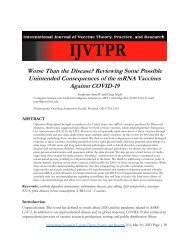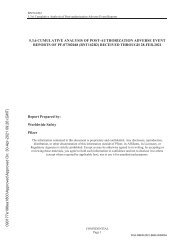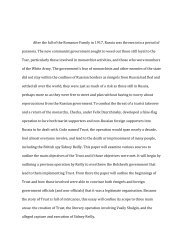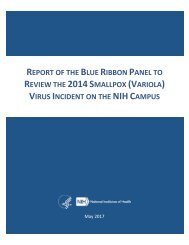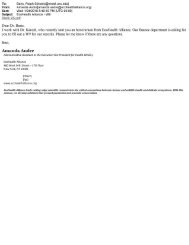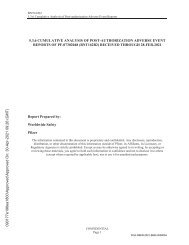22_0207 National Terrorism Advisory System Bulletin
Joe Biden’s Department of Homeland Security (DHS) declared a heightened terrorism threat due to “several factors, including an online environment filled with false or misleading narratives and conspiracy theories.”
Joe Biden’s Department of Homeland Security (DHS) declared a heightened terrorism threat due to “several factors, including an online environment filled with false or misleading narratives and conspiracy theories.”
You also want an ePaper? Increase the reach of your titles
YUMPU automatically turns print PDFs into web optimized ePapers that Google loves.
<strong>National</strong> <strong>Terrorism</strong> <strong>Advisory</strong> <strong>System</strong><br />
<strong>Bulletin</strong><br />
DHS.gov/advisories<br />
February 7, 20<strong>22</strong> 2:00 PM ET<br />
This <strong>Bulletin</strong> will expire on<br />
June 7, 20<strong>22</strong> at 2:00 PM ET<br />
**The NTAS <strong>Bulletin</strong> issued on November 10, 2021 and<br />
set to expire on February 8, 20<strong>22</strong> is hereby canceled.**<br />
SUMMARY OF THE TERRORISM THREAT TO THE UNITED STATES<br />
The United States remains in a heightened threat environment fueled by several factors, including an online environment filled with false or<br />
misleading narratives and conspiracy theories, and other forms of mis- dis- and mal-information (MDM) introduced and/or amplified by foreign<br />
and domestic threat actors. These threat actors seek to exacerbate societal friction to sow discord and undermine public trust in government<br />
institutions to encourage unrest, which could potentially inspire acts of violence. Mass casualty attacks and other acts of targeted violence<br />
conducted by lone offenders and small groups acting in furtherance of ideological beliefs and/or personal grievances pose an ongoing threat to<br />
the nation. While the conditions underlying the heightened threat landscape have not significantly changed over the last year, the convergence<br />
of the following factors has increased the volatility, unpredictability, and complexity of the threat environment: (1) the proliferation of false or<br />
misleading narratives, which sow discord or undermine public trust in U.S. government institutions; (2) continued calls for violence directed at<br />
U.S. critical infrastructure; soft targets and mass gatherings; faith-based institutions, such as churches, synagogues, and mosques; institutions of<br />
higher education; racial and religious minorities; government facilities and personnel, including law enforcement and the military; the media; and<br />
perceived ideological opponents; and (3) calls by foreign terrorist organizations for attacks on the United States based on recent events.<br />
ADDITIONAL INFORMATION<br />
The primary terrorism-related threat to the United States continues to stem from lone offenders<br />
or small cells of individuals who are motivated by a range of foreign and/or domestic grievances<br />
often cultivated through the consumption of certain online content. The convergence of violent<br />
extremist ideologies, false or misleading narratives, and conspiracy theories have and will<br />
continue to contribute to a heightened threat of violence in the United States.<br />
Key factors contributing to the current heightened threat environment include:<br />
(1) The proliferation of false or misleading narratives, which sow discord or undermine<br />
public trust in U.S. government institutions:<br />
For example, there is widespread online proliferation of false or misleading narratives<br />
regarding unsubstantiated widespread election fraud and COVID-19. Grievances<br />
associated with these themes inspired violent extremist attacks during 2021.<br />
Malign foreign powers have and continue to amplify these false or misleading<br />
narratives in efforts to damage the United States.<br />
(2) Continued calls for violence directed at U.S. critical infrastructure; soft targets and mass<br />
gatherings; faith-based institutions, such as churches, synagogues, and mosques;<br />
institutions of higher education; racial and religious minorities; government facilities<br />
and personnel, including law enforcement and the military; the media; and perceived<br />
ideological opponents:<br />
Foreign terrorist organizations and domestic threat actors continue to amplify preexisting<br />
false or misleading narratives online to sow discord and undermine public trust<br />
in government institutions. Some of these actors do so to encourage unrest, which<br />
could lead to acts of violence against the facilities, individuals, institutions, and<br />
organizations cited above.<br />
Violent extremists inspired by a range of grievances and ideologies continue to target<br />
crowded venues traditionally perceived to be soft targets, such as commercial and<br />
publicly accessible facilities, public gatherings, certain government and state facilities,<br />
and houses of worship.<br />
The recent attack on a synagogue in Colleyville, Texas highlights the continuing threat<br />
of violence based upon racial or religious motivations, as well as threats against faithbased<br />
organizations.<br />
RESOURCES TO STAY SAFE<br />
Stay Informed and Prepared<br />
<br />
<br />
<br />
<br />
<br />
Be prepared for emergency situations and<br />
remain aware of circumstances that may<br />
place you at risk. Make note of your<br />
surroundings and the nearest security<br />
personnel.<br />
Keep yourself safe online and maintain<br />
digital and media literacy to recognize and<br />
build resilience to false or misleading<br />
narratives.<br />
Review DHS resources for how to better<br />
protect businesses, houses of worship, and<br />
schools, and ensure the safety of public<br />
gatherings.<br />
Prepare for potential active shooter<br />
incidents, as well as efforts to prevent,<br />
protect against, respond to, and mitigate<br />
the use of explosives.<br />
Learn more about community-based<br />
resources to help prevent individuals from<br />
radicalizing to violence.<br />
Report Potential Threats<br />
<br />
<br />
<br />
Listen to local authorities and public safety<br />
officials.<br />
If You See Something, Say Something®<br />
Report suspicious activity and threats of<br />
violence, including online threats, to local<br />
law enforcement, FBI Field Offices, or your<br />
local Fusion Center. Call 911 in case of<br />
emergency.<br />
If you know someone who is struggling<br />
with mental health issues or may pose a<br />
danger to themselves or others, seek help.<br />
If You See Something, Say Something® – Report suspicious activity to local law enforcement or call 911.<br />
The <strong>National</strong> <strong>Terrorism</strong> <strong>Advisory</strong> <strong>System</strong> provides information on homeland security issues and threats. It is distributed by the Department of Homeland Security.<br />
More information is available at: DHS.gov/advisories. To receive mobile updates: Twitter.com/dhsgov.<br />
If You See Something, Say Something® used with permission of the NY Metropolitan Transportation Authority.
<strong>National</strong> <strong>Terrorism</strong> <strong>Advisory</strong> <strong>System</strong><br />
<strong>Bulletin</strong><br />
DHS.gov/advisories<br />
February 7, 20<strong>22</strong> 2:00 PM ET<br />
This <strong>Bulletin</strong> will expire on<br />
June 7, 20<strong>22</strong> at 2:00 PM ET<br />
**The NTAS <strong>Bulletin</strong> issued on November 10, 2021 and<br />
set to expire on February 8, 20<strong>22</strong> is hereby canceled.**<br />
Threats directed at Historically Black Colleges and Universities (HBCUs) and other colleges and universities, Jewish facilities, and<br />
churches cause concern and may inspire extremist threat actors to mobilize to violence.<br />
As COVID-19 restrictions continue to decrease nationwide, increased access to commercial and government facilities and the rising<br />
number of mass gatherings could provide increased opportunities for individuals looking to commit acts of violence to do so, often with<br />
little or no warning. Meanwhile, COVID-19 mitigation measures—particularly COVID-19 vaccine and mask mandates—have been used<br />
by domestic violent extremists to justify violence since 2020 and could continue to inspire these extremists to target government,<br />
healthcare, and academic institutions that they associate with those measures.<br />
Domestic violent extremists have also viewed attacks against U.S. critical infrastructure as a means to create chaos and advance<br />
ideological goals, and have recently aspired to disrupt U.S. electric and communications critical infrastructure, including by spreading<br />
false or misleading narratives about 5G cellular technology.<br />
Some domestic violent extremists have continued to advocate for violence in response to false or misleading narratives about<br />
unsubstantiated election fraud. The months preceding the upcoming 20<strong>22</strong> midterm elections could provide additional opportunities for<br />
these extremists and other individuals to call for violence directed at democratic institutions, political candidates, party offices, election<br />
events, and election workers.<br />
A small number of threat actors are attempting to use the evacuation and resettlement of Afghan nationals following the U.S. military<br />
withdrawal from Afghanistan last year as a means to exacerbate long-standing grievances and justify attacks against immigrants.<br />
(3) Calls by foreign terrorist organizations for attacks on the United States based on recent events:<br />
Foreign terrorist organizations will likely continue to maintain a highly visible online presence to attempt to inspire U.S.-based<br />
individuals to engage in violent activity.<br />
Supporters of foreign terrorist organizations have encouraged copycat attacks following the January 15, 20<strong>22</strong> attack on a synagogue in<br />
Colleyville, Texas.<br />
Foreign terrorists remain intent on targeting the United States and U.S. persons, and may seek to capitalize on the evolving security<br />
environment overseas to plot attacks. The Islamic State of Iraq and ash-Sham (ISIS) or its affiliates may issue public calls for retaliation<br />
due to the strike that recently killed ISIS leader Abu Ibrahim al-Hashimi al-Qurayshi.<br />
HOW WE ARE RESPONDING<br />
<br />
<br />
<br />
<br />
<br />
<br />
<br />
DHS and the Federal Bureau of Investigation (FBI) continue to share timely and actionable information and intelligence with the<br />
broadest audience possible. This includes sharing information and intelligence with our partners across every level of government and<br />
in the private sector. We conduct recurring threat briefings with private sector and state, local, tribal, territorial, and campus partners,<br />
including to inform security planning efforts. DHS remains committed to working with our partners to identify and prevent all forms of<br />
terrorism and targeted violence, and to support law enforcement efforts to keep our communities safe.<br />
DHS’s Office of Intelligence and Analysis established a new, dedicated domestic terrorism branch to produce the sound, timely<br />
intelligence needed to counter related threats. The Department expanded its evaluation of online activity as part of its efforts to assess<br />
and prevent acts of violence, while ensuring the protection of privacy, civil rights, and civil liberties.<br />
DHS’s Center for Prevention Programs and Partnerships (CP3) provides communities with resources and tools to help prevent<br />
individuals from radicalizing to violence. In 2021, CP3 awarded about $20 million in grants through its Targeted Violence and <strong>Terrorism</strong><br />
Prevention Grant Program. CP3 also partners with local communities to raise awareness about how to prevent violence.<br />
In 2021, DHS designated domestic violent extremism as a “<strong>National</strong> Priority Area” within its Homeland Security Grant Program (HSGP),<br />
resulting in at least $77 million being spent on preventing, preparing for, protecting against, and responding to related threats.<br />
In 2021, DHS’s Nonprofit Security Grant Program (NSGP) provided $180 million in funding to support target hardening and other<br />
physical security enhancements to non-profit organizations at high risk of terrorist attack.<br />
DHS is working with public and private sector partners, as well as foreign counterparts, to identify and evaluate MDM, including false or<br />
misleading narratives and conspiracy theories spread on social media and other online platforms that endorse or could inspire violence.<br />
DHS’s Cybersecurity and Infrastructure Security Agency (CISA) works with public and private sector partners – including U.S. critical<br />
infrastructure owners and operators – to mitigate risk against our cyber and physical infrastructure and increase nationwide<br />
cybersecurity resilience.<br />
If You See Something, Say Something® – Report suspicious activity to local law enforcement or call 911.<br />
The <strong>National</strong> <strong>Terrorism</strong> <strong>Advisory</strong> <strong>System</strong> provides information on homeland security issues and threats. It is distributed by the Department of Homeland Security.<br />
More information is available at: DHS.gov/advisories. To receive mobile updates: Twitter.com/dhsgov.<br />
If You See Something, Say Something® used with permission of the NY Metropolitan Transportation Authority.


